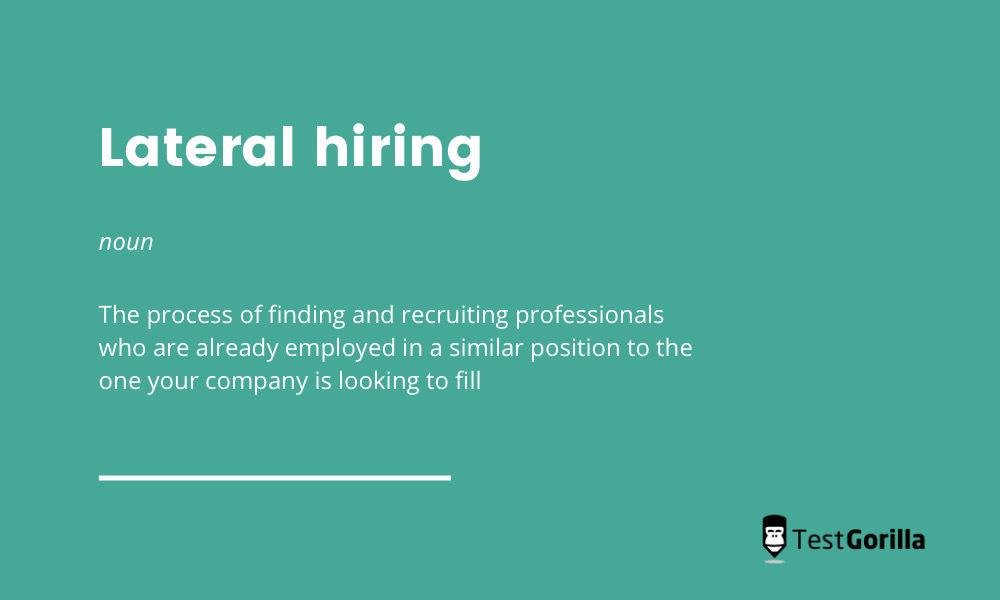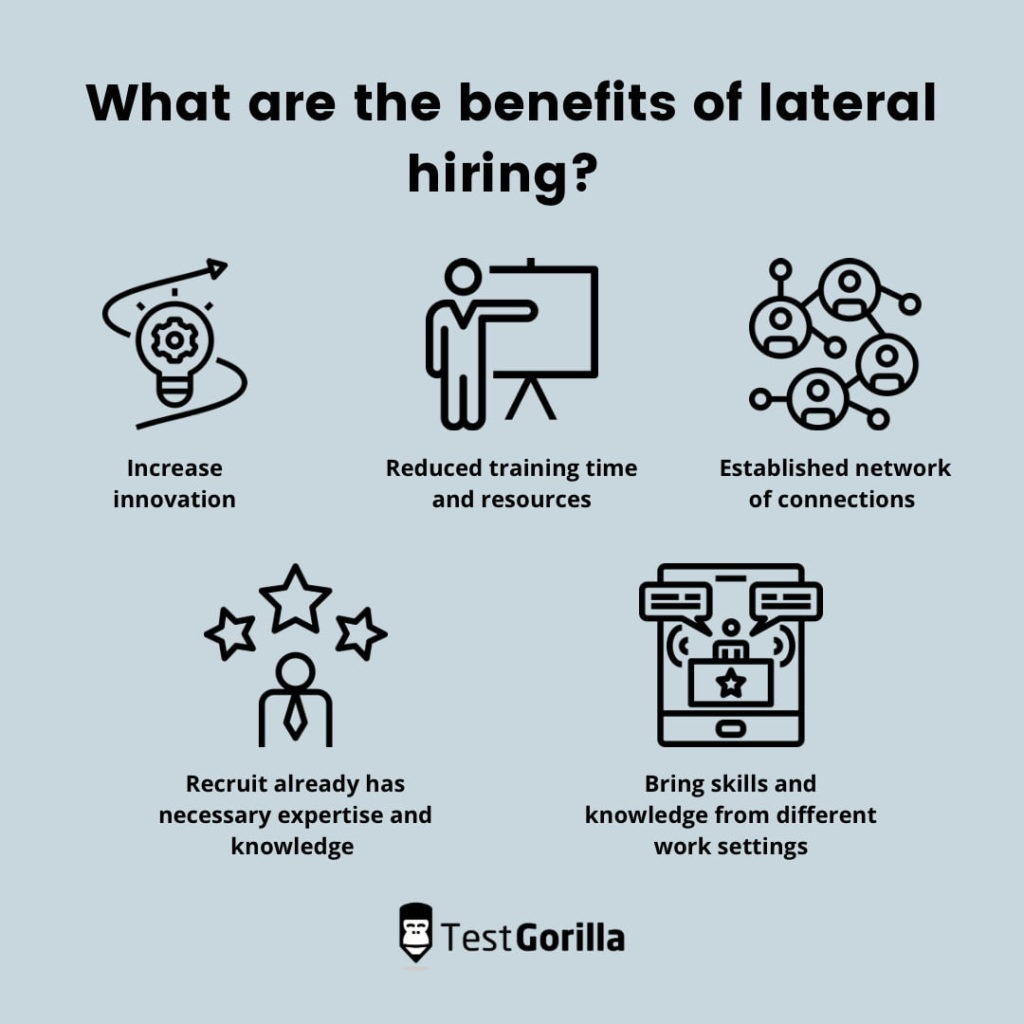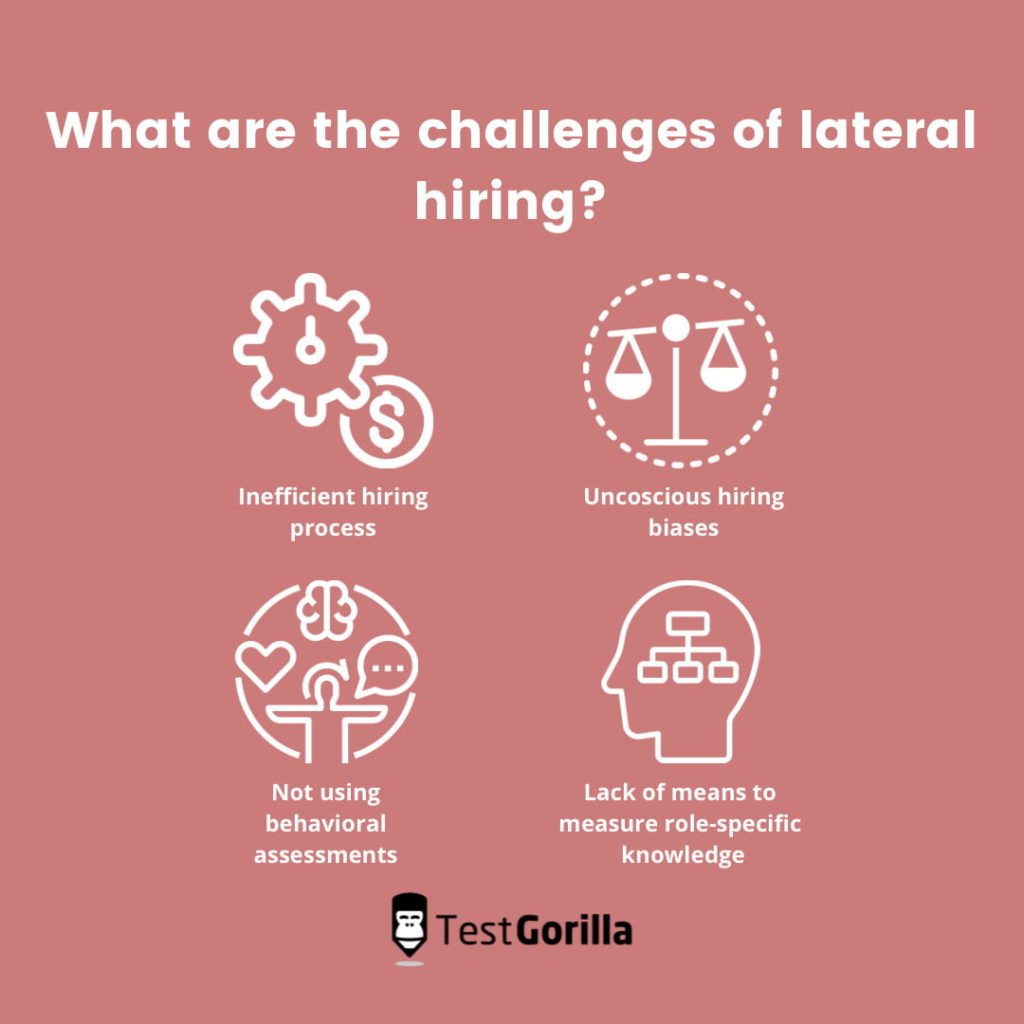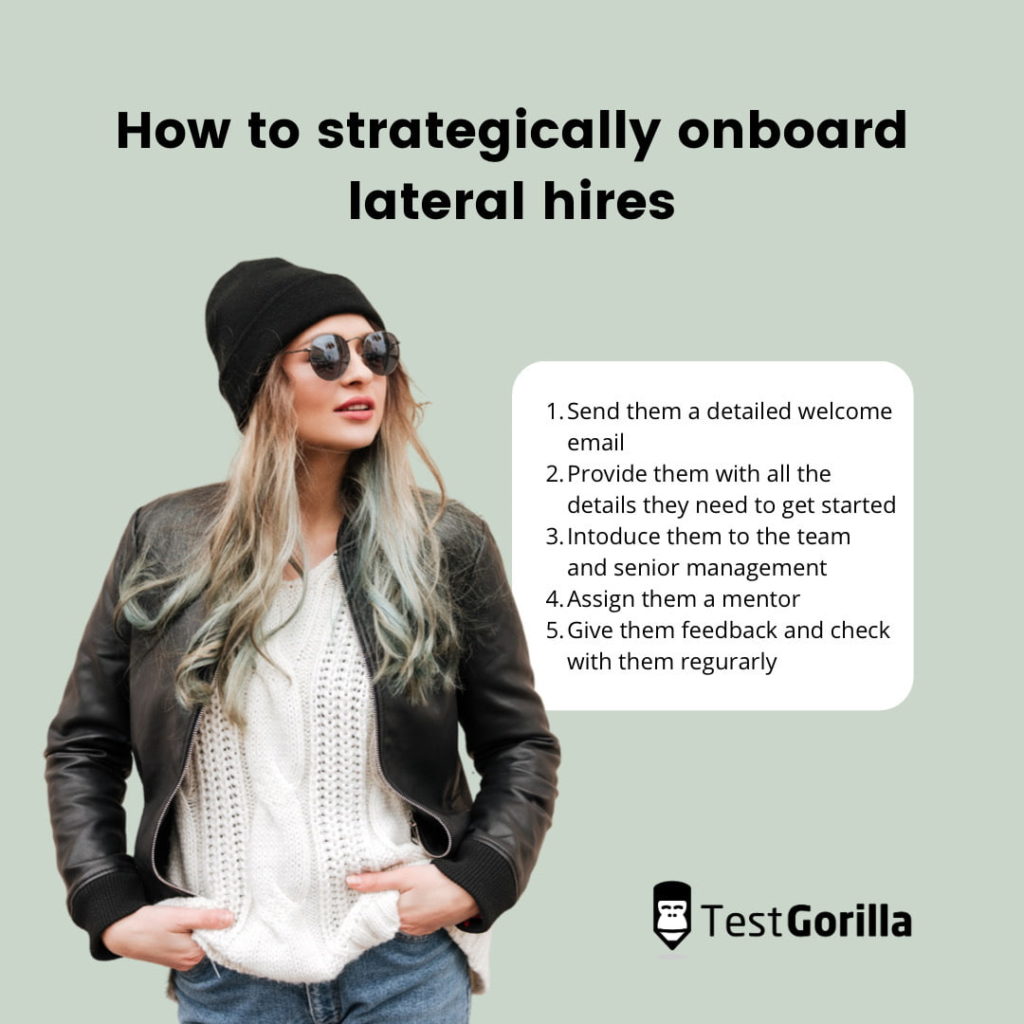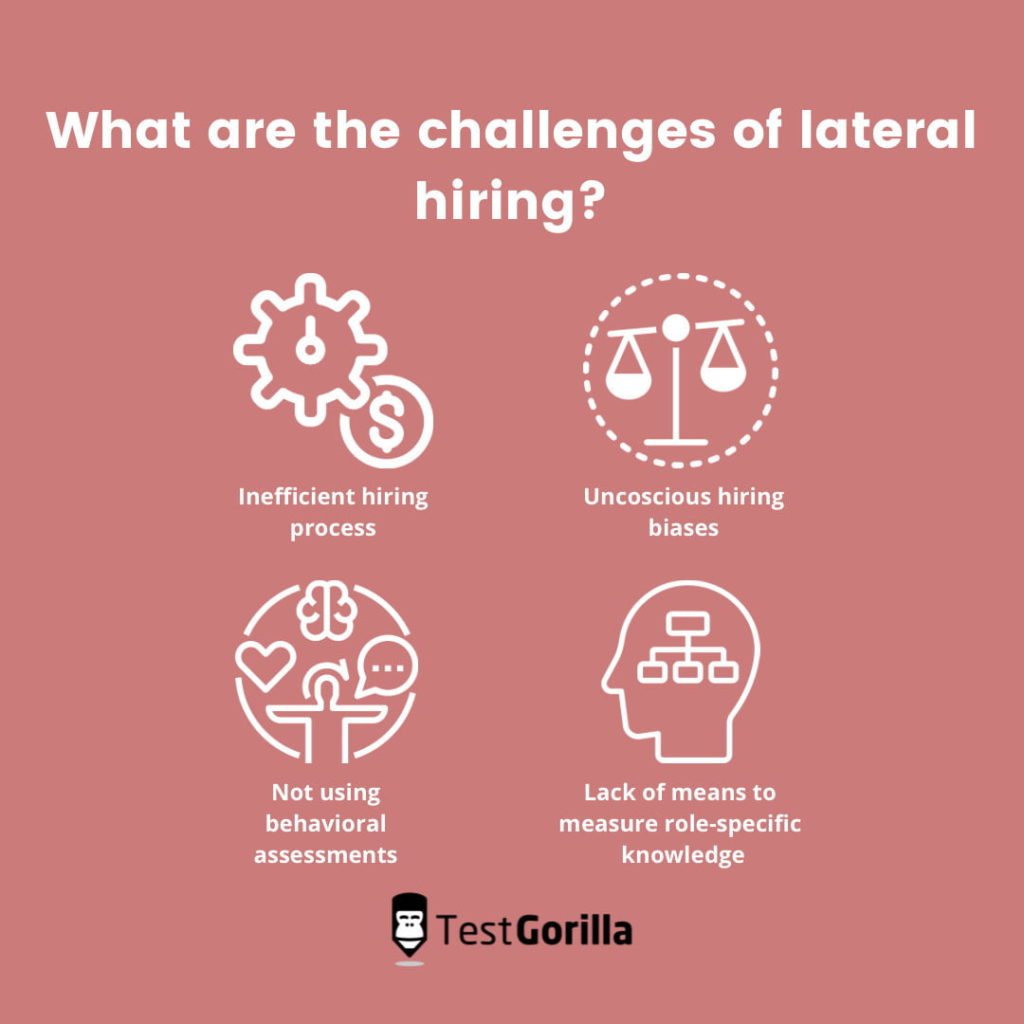Lateral hiring, or the practice of hiring passive candidates for highly specialized positions, can prove to be an invaluable recruitment strategy.
It involves hiring candidates who already have at least a few years of experience under their belts in similar positions and who can help lead your organization and boost performance.
Otherwise said, you hire an already seasoned professional who can quickly get up to speed and doesn’t need a similar onboarding process as a less experienced candidate or even someone who is promoted from within the company.
Table of contents
- What is lateral hiring?
- How is lateral hiring a form of confidential hiring?
- What are the benefits of lateral hiring?
- When should you consider lateral recruiting?
- What does the lateral hiring process look like?
- The 7 essential steps of lateral recruitment
- Challenges you may face in lateral hiring
- TestGorilla can help you find top candidates to fill high-level positions in your company with lateral recruitment
What is lateral hiring?
Lateral hiring is the process of finding and recruiting professionals who are already employed in a similar position to the one your company is looking to fill. Such professionals are deemed passive candidates and are not actively searching for a new job.
Most of the time, these candidates are happy with their current position and won’t necessarily be open to job offers – unless the opportunity is attractive enough (in terms of career advancement, for example).
They already have an established reputation as a professional in their field of expertise, along with a large network of connections and the soft and hard skills needed to succeed in their role.
Nevertheless, these candidates are ideal if you’re looking to fill an open position at your organization that requires specific, niche expertise.
This is when lateral recruitment can prove to be a highly effective strategy. It enables you to find someone who already has the necessary experience to come aboard and get the job done.
This way, instead of going through the trouble of hiring someone who lacks these skills and having to train them from the start, you hire a highly qualified candidate who can hit the ground running.
How is lateral hiring a form of confidential hiring?
Usually, a business advertises open positions through its social media channels (like LinkedIn), via its website, on external recruiter sites, and within the company’s own talent pool.
In other words, the business puts the word out that it’s hiring and expects people to apply for the advertised position. The candidates who apply go through a screening process. Those who are shortlisted are then invited for an interview, and finally, one or more candidates are offered a position.
On the other hand, when you use a lateral hiring process, you don’t publish a job ad on job boards, LinkedIn, or your website.
Although you are actively searching for someone to fill a specific role, you’re not expecting people to apply for the position since you never advertised it in the first place.
Instead, once you find an ideal candidate, the negotiation process is more or less buttoned up.
With lateral hiring, you typically want your team to be composed of your company’s executive members, and the management team and the rest of the staff will likely be unaware of the hiring process until it is complete.
You need to do this to protect the prospective candidates, who already have a secure job and don’t want their current employer to find out that one of their employees is thinking of leaving them.
In addition, it’s a way of averting speculation by your organization’s stakeholders, especially if there is a merger at hand or if the business is expanding and needs the support of a trained expert to go through this process.
You don’t want to attract unnecessary media coverage or show any signs of weakness while going through such a period. This may damage the company’s reputation and its position in the industry and invite the scrutiny of rival companies that will want to take over your position in the market.
The best insights on HR and recruitment, delivered to your inbox.
Biweekly updates. No spam. Unsubscribe any time.
What are the benefits of lateral hiring?
Lateral hiring can be extremely beneficial to your business in both the short and long term.
First, if you recruit someone laterally, you get a professional who already has the necessary expertise and knowledge to do their job, reducing the time and resources you spend on training them.
This is important when you need to fill a position that requires specific skills, especially when you are dealing with talent shortages or simply don’t have the time to get new hires up to speed with what needs to be done.
Second, lateral hires can revamp your company by bringing in their own wealth of knowledge and soft and hard skills that they have honed in a different work setting. This can lead to an increase in innovation – and studies have continuously shown that organizations that embrace innovation enjoy better productivity and improved business outcomes.
Third, as mentioned, lateral hires already have their own established network of connections that can benefit your company in the long run.
When should you consider lateral recruiting?
Lateral recruiting can be used in any organization or industry, although it’s particularly suited for highly competitive industries in which niche knowledge is key to success.
You can also use lateral hiring when your business is expanding and going through some sort of transition, like a merger with another company.
A lateral hire with the necessary field expertise can help your company navigate this uncertain process to remain competitive and meet business goals.
Once you reveal the news of the expansion and/or merger, the lateral appointment of someone with a proven track record of successful mergers will put both shareholders and stakeholders at ease.
Of course, you can always opt for a lateral hire in other circumstances, like if you need an expert to take over a recently vacated position and you have no suitable candidates to choose from in your own talent pool.
What does the lateral hiring process look like?
Once a position has been clearly defined, the lateral hiring process should be managed by an HR executive or an external recruiter (headhunter) in close co-operation with the executive team.
The reason for this is that such roles require highly specific knowledge and skills. In many cases, only the top management knows the exact details of what is required.
This is why the person in charge of the lateral hiring process must be well informed about the role’s requirements, the company’s business goals, and the remuneration and benefits they can offer to the potential candidate.
Once the executive team identifies a suitable candidate for the role, they usually hire an external recruiter to attempt to contact them.
This is done to avoid litigation if a competing firm learns that you’re trying to pinch one of its staff.
In addition, trying to poach the competition’s top employees can be seen as unprofessional and may cause you headaches, even though it’s commonplace among big businesses.
The 7 essential steps of lateral recruitment
Lateral hiring is similar to other forms of recruitment in that the end goal is to find the best candidate for the job.
Its mechanics, however, are different from those of traditional hiring processes.
Since there is no open call for the job and it has not been advertised anywhere, you are looking for someone who is already an established name in their field.
Essentially, you try to court a candidate who is probably happy with their job to come over and work for your company. Having said that, you want to make them an irresistible offer they simply cannot turn down.
These are the seven critical steps you should follow to make the lateral hiring process a success.
1. Define what your company needs
First of all, you need to establish your organization’s goals and determine how the lateral hire can help you achieve them.
You must clearly define the role and list all the specific skills and expertise required for it. The ideal candidate should have a thorough understanding of the field they are working in, the challenges they’ll face once they join you, and how to tackle them.
In addition, they should have a proven track record in a similar role with their previous or current employer.
2. Research every potential prospect
Lateral hires will not be easy to find, especially since you are not publicly advertising for the job opening.
Additionally, candidates will already be working somewhere else and might have no intention of moving to another company.
This is why you need to broaden your search beyond your local geographical area and sometimes even venture into other countries to find the perfect match.
You can ask yourself the following questions when trying to find that perfect candidate:
Who has recently been in the media spotlight for their achievements?
Who has been actively participating in your field by publishing reports, papers, and articles?
Who has been attending events and symposiums and is well known in the industry?
The answers to these questions will enable you to find several candidates who are perfect for lateral hiring.
At this stage, you can begin researching their track records and success stories and shortlisting those who stand out.
Once you shortlist the best candidates, you must thoroughly investigate each individual.
Since most (if not all) of them will hold top positions with their current employers, you might be able to find detailed information about their previous work, reviews from colleagues on LinkedIn, interviews they have given, and other success stories they might have.
This will give you deeper insight into each person, their work ethic, and their ability to tackle serious challenges.
Once you’re satisfied with your findings, you can compile a list of benefits that can attract the ideal candidate.
3. Define why your company is a better choice than the candidates’ current one
Most lateral recruitment is done on an executive level, and remuneration is usually similar across the field.
For this reason, more money will probably not be the main motivating factor that will make candidates want to join you.
Instead, you want to use all that research you did on them to find out what would entice them to leave their current employer.
Perhaps it will be specific perks that their current company doesn’t offer. Maybe your organization’s values and mission will attract them.
You can also offer them a position, even one you create specifically for them, that provides more exciting career-growth opportunities. You can even tempt them with a specific project that only they can handle due to their proven track record.
In this step, you want to sell your business and what it can offer. You need to make this offer as enticing as possible so that the candidate will certainly consider the job position, even if they are initially unwilling to switch companies.
You’ll require creativity and flexibility to find the right buttons to push to get them on board.
4. Discreetly contact candidates
When you have set your eyes on someone, it’s time to contact them.
You should do this with the utmost care and discretion since these people are already established figures at their workplace. As mentioned, they’re passive candidates and are not actively looking for a new role.
Approach them delicately and don’t arouse any suspicion from their current employer. It can be a good idea to assign this task to an external recruiter who is perfectly aware of your needs and wants.
When you first contact them, simply introduce yourself, say you have a career opportunity for them, and ask if they would be interested to hear more. If you get a yes, you can schedule a meeting.
Don’t ask candidates for their CVs, and definitely don’t communicate with them as you would in a normal interview by asking detailed questions, demanding information from them, and expecting them to be willing to engage in a lengthy discussion.
Instead, deliver your pitch and wait for their reply.
If you get a no, don’t push it and try to convince them – just move on to the next person on your shortlist. The less information you divulge to an uninterested candidate, the better. You don’t want them spilling your secrets to the competition.
5. Negotiate
The negotiating stage of lateral hiring begins shortly after you contact your prospective hire.
This is when you need to make a pitch and entice this person to join your organization. They probably already have a solid compensation package, so you want to offer them similar, if not better, perks.
It’s also a good idea to present them with the opportunity to work in a more challenging role – one in which they will feel in their element and can take charge and be creative. It’s often these kinds of motivating factors, rather than slightly better remuneration, that will make them want to join your company.
6. Make an offer
If the prospect says yes, you need to act quickly and make them an offer they can accept before they lose interest.
Such people are often happy with where they are, and although an enticing new project might intrigue them at first, if you’re too slow to make an offer, they may change their minds and stay in their current position.
Ensure that your offer meets all their expectations, and consider giving them a little extra on top of what you initially negotiated to sweeten the deal even further.
7. Onboard lateral hires strategically
Properly onboarding new hires is perhaps even more important in a lateral hiring process than in normal recruitment.
Though lateral hires will likely not need as much training on how to perform their job as other hires, they will need to be integrated into your company and the team and immerse themselves in the organization’s culture and values.
This is vital if you want to retain them and get all the benefits of hiring a candidate with considerable expertise.
According to a study by ALM Rival Edge, 47% of lateral hires made by law firms do not stay a full five years after being hired, which is detrimental and costly to the firms in the long term.
This is because it takes two to three years for the new hires to come up to speed at the firm and several more years to produce the desired results to the point where the firm regains the costs of recruitment and compensation.
This typically happens when lateral hires have not been onboarded correctly and do not feel well established in their new position. Although this study only examined law firms, we can assume the same holds true for other fields as well.
This is why you must have a great onboarding program ready for your lateral hires.
Here are the steps you should take after you’ve hired them:
Step 1: Send them a detailed welcome email
Send your new hires a welcome email that provides details about their job and a specific description of what they will be doing.
You can include any useful information here that might help the lateral hires feel more informed and prepared to enter their new workplace.
Step 2: Provide them with all the details they need to get started
Prepare all the documentation and information your hires will need to access and use their work station, accounts, emails, and passwords.
Provide them with the most relevant contacts in your firm who can aid them immediately if they have queries or problems starting their job.
Step 3: Introduce them to the team and senior management
It’s crucial to introduce lateral hires to all staff members who are directly under their charge, the senior management, the executive team, and the stakeholders.
This will establish who is in charge of what, who they need to report to, and who reports to them.
Do not leave them to introduce themselves since most people will shy away from such an endeavor.
Instead, help them to get to know everyone so that they feel at home right from the start.
Step 4: Assign them a mentor
Even though the lateral hire will be a person of expertise, they will still need someone to show them the ropes of the business, give them suggestions for where to go to lunch, let them know who to talk to if they have a problem, or just keep them in the loop about company events and social gatherings.
Ideally, you should choose someone with about the same level of experience and skill as the new employee to be their mentor.
Otherwise, the hire may be unable to build rapport with their superior, and the mentorship might break down.
Step 5: Give them feedback and check with them regularly
Finally, you want to give lateral hires feedback on their work progress and, in turn, request feedback from them to find out how they are settling in the company.
You can address any issues and concerns they might have with their current role by adjusting to their needs, scheduling additional training if required, and providing them with the tools they need to do their job successfully.
Following these principles will surely make the onboarding process much easier for your lateral hires and keep your retention rates high by preventing them from leaving prematurely.
Challenges you may face in lateral hiring
Lateral hiring comes with its own set of challenges that you need to be aware of to build a successful hiring strategy.
1. An inefficient hiring process
A lateral hiring process is completely different from the “normal way of hiring.”
You don’t create an open job ad and might not be able to use traditional software tools to sift through potential candidates. This is because you are trying to discreetly recruit someone who is an established figure in their field of expertise and works at a different organization, so you don’t have the luxury of screening them extensively, lest you drive them away.
This makes the hiring process more challenging since you have to rely solely on your research and approach candidates based on your findings.
Furthermore, even if someone looks good on paper, they may not always be the perfect fit for your company. Since they already have a solid reputation and background, they might want to establish their own values and beliefs in your firm, which may be detrimental to the rest of the team.
You don’t want to hire someone who doesn’t work well with their team members, even if they have the perfect expertise for the job.
This is why you should implement a rigid filtration process to screen out candidates who aren’t right for the role.
To help accomplish this, you can use pre-employment skills tests to assess candidates’ skills – although it’s best to administer only a few tests for abilities that are critical for the position.
2. Unconscious hiring biases
Another issue with lateral recruitment is that you may form an unconscious bias toward a candidate.
This may happen if you rely solely on your research about them, any media coverage they might have had, or written work they might have published.
Apart from that, you may form a positive opinion about someone once you meet them and thus disregard any red flags that would otherwise be revealed during the screening process.
To minimize bias, we recommend using a skills assessment to evaluate candidates’ skills objectively and make an informed decision.
3. Not using behavioral assessments
As with unconscious hiring biases, not assessing the behavior of your prospective lateral hire makes the whole process a time-consuming and costly endeavor.
This is especially true if you find out that although the person you hired laterally is good at their job, their values don’t align with your organizational culture.
Behavioral assessments are essentially personality tests that can predict how candidates will act in certain situations.
Even though you might be reluctant to give a lateral hire these kinds of tests due to the nature of the hiring process, doing so can help you make sure that their personality and values align with those of your company.
Therefore, it’s a good idea to use personality and culture tests in lateral hiring, but you need to make sure the assessment process is as streamlined as possible so that candidates don’t lose interest.
Online pre-employment assessments like TestGorilla can be an invaluable tool in this situation. Our tests only take 10 minutes to complete and help you create a positive candidate experience.
4. A lack of means to measure role-specific knowledge
Finally, even if a candidate seems perfect for a job, you should still give them a test that assesses their role-specific knowledge to ensure they are the right person for the role.
However, you need to tread carefully and not offend candidates when you ask to test their skills. After all, they are experienced professionals in their fields, which is why you approached them in the first place.
TestGorilla can help you find top candidates to fill high-level positions in your company with lateral recruitment
You can make it easier to assess the skills and knowledge of lateral hires by using TestGorilla’s skills tests during the screening process.
Remember to narrow down the tests you want to administer and use other evaluation and research methods to get accurate information about your candidate’s broad skill set.
You can also use the results of their skills tests during and after the onboarding process.
Even after you’ve hired a candidate, you can use their results to find skills gaps and see how they improve with time.
You can discuss the results with your new employee and design a personalized training plan to help them grow in their role and reach their true performance potential. This also shows them that you value their skills and are interested in helping hone them even further at their new job.
With TestGorilla, you’ll find the recruitment process to be simpler, faster, and much more effective.
Get started for free today and start making better hiring decisions, faster and bias-free.
You've scrolled this far
Why not try TestGorilla for free, and see what happens when you put skills first.


